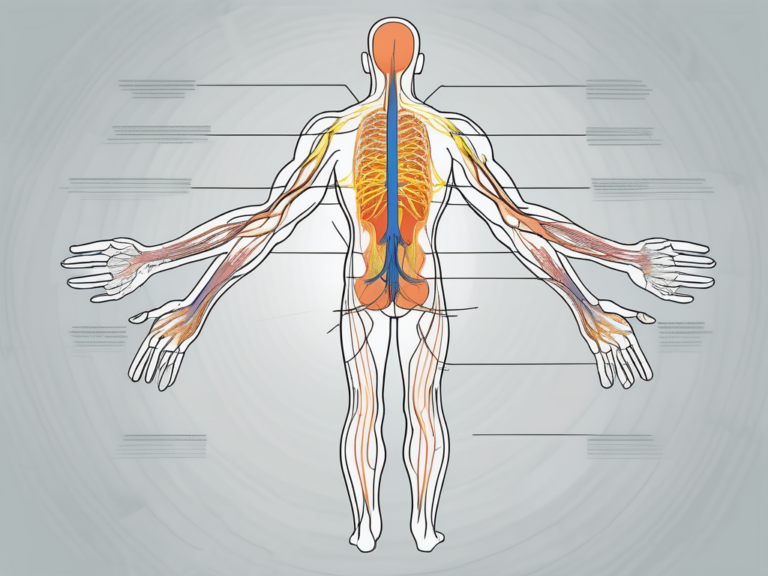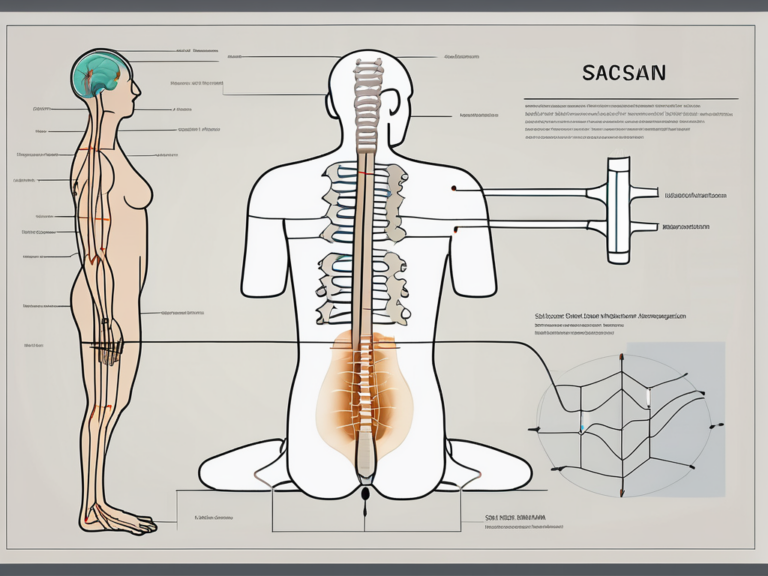Which Nerve of the Sacral Plexus is the Largest and Longest Nerve in the Body?
The sacral plexus is a crucial part of the nervous system, responsible for controlling various motor and sensory functions in the lower body. Within this network of nerves lies a particular nerve that holds the title for being both the largest and longest in the entire human body. In this article, we will explore the anatomy, function, and significance of this remarkable nerve.
Understanding the Sacral Plexus
The sacral plexus is a fascinating network of nerve roots called ventral rami, which originate from the spinal cord segments L4 to S4. These nerve roots combine and branch out to form the sacral plexus, a complex web of interconnected nerves that plays a crucial role in transmitting signals between the central nervous system and the lower limbs, pelvis, and perineum.
But let’s dive deeper into the anatomy of the sacral plexus. It consists of multiple nerves, each with its own unique function. For instance, we have the superior gluteal nerve, which innervates the gluteus medius, gluteus minimus, and tensor fasciae latae muscles. These muscles are essential for maintaining stability and balance while walking or running.
On the other hand, we have the inferior gluteal nerve, which innervates the gluteus maximus muscle, the largest muscle in the buttocks. This nerve allows us to perform powerful movements such as climbing stairs or standing up from a seated position.
Another nerve within the sacral plexus is the posterior cutaneous nerve of the thigh. This nerve provides sensory innervation to the back of the thigh, allowing us to perceive sensations like touch, pressure, or even pain in this area.
But perhaps the most well-known nerve within the sacral plexus is the sciatic nerve. It is the largest and longest nerve in our body, originating from the sacral plexus and extending down the back of the thigh. The sciatic nerve branches out to provide motor innervation to the hamstrings, as well as sensory innervation to the back of the thigh, leg, and foot.
Function of the Sacral Plexus
Now that we have a better understanding of the anatomy, let’s explore the incredible functions of the sacral plexus. As mentioned earlier, it is responsible for providing innervation to numerous muscles in the lower body, enabling us to perform essential movements such as walking, running, and maintaining balance.
Imagine taking a leisurely stroll in the park. It is the sacral plexus that allows your brain to send signals to your leg muscles, coordinating their contraction and relaxation to create a smooth and coordinated walking motion. Without the sacral plexus, such simple activities would become impossible.
But the sacral plexus doesn’t stop at motor innervation. It also carries sensory information from the lower limbs back to the brain, allowing us to perceive various sensations. Whether it’s the feeling of grass beneath our feet, the warmth of the sun on our skin, or even the sharp pain from stepping on a sharp object, the sacral plexus plays a vital role in our sensory experiences.
So, the next time you take a step or feel a gentle breeze on your leg, remember to thank your sacral plexus for its incredible work. Without this complex network of nerves, our lower body would be devoid of movement and sensation, making life a lot less interesting and enjoyable.
Identifying the Largest and Longest Nerve
Within the sacral plexus, the sciatic nerve takes the spotlight as the largest and longest nerve in the human body. This nerve originates from the nerve roots L4 to S3 and consists of two distinct divisions: the tibial nerve and the common fibular nerve.
Characteristics of the Largest Nerve
The sciatic nerve is approximately as thick as a finger and extends from the lower back, through the pelvis, down the back of the thigh, and ultimately branches out to supply the muscles in the lower leg and foot. The sheer length and size of the sciatic nerve make it a vital player in the functioning of the lower limbs.
Let’s delve deeper into the anatomy of the sciatic nerve. Emerging from the sacral plexus, the nerve travels through the greater sciatic foramen, a passageway in the pelvis. As it courses down the back of the thigh, it becomes more superficial, making it susceptible to injury and compression.
One interesting fact about the sciatic nerve is that it is not a single nerve, but rather a combination of multiple nerve fibers bundled together. These fibers originate from the spinal cord and merge to form the sciatic nerve, which then splits into the tibial nerve and the common fibular nerve.
Role of the Longest Nerve in the Body
The sciatic nerve plays a crucial role in transmitting signals for movement and sensation in the lower limbs. It provides motor signals to numerous muscles involved in leg and foot movement, including the hamstrings, calf muscles, and muscles of the foot. Additionally, the sciatic nerve carries sensory information, allowing us to feel sensations such as pressure, temperature, and pain in the back of the leg, calf, and foot.
Imagine taking a step forward or standing on your tiptoes. These actions are made possible by the coordinated contraction of various muscles, all controlled by the sciatic nerve. Without the sciatic nerve, our lower limbs would be rendered immobile, affecting our ability to walk, run, or even stand.
It is worth noting that the sciatic nerve can sometimes be prone to compression or injury, leading to a condition known as sciatica. Sciatica is characterized by pain, numbness, or tingling sensations that radiate along the path of the nerve, often starting in the lower back and traveling down the leg. This condition can be caused by various factors, such as a herniated disc, spinal stenosis, or even muscle imbalances.
Given its importance and vulnerability, it is essential to take proper care of the sciatic nerve. Maintaining good posture, engaging in regular exercise to strengthen the supporting muscles, and avoiding prolonged sitting or standing can help prevent issues related to the sciatic nerve.
In conclusion, the sciatic nerve stands out as the largest and longest nerve in the human body. Its significant size and extensive course make it a critical player in the functioning of our lower limbs. From transmitting motor signals to allowing us to perceive sensations, the sciatic nerve plays a vital role in our everyday movements and overall well-being.
The Relationship between the Sacral Plexus and the Body’s Longest Nerve
Understanding the relationship between the sacral plexus and the sciatic nerve is essential in comprehending the significance of this immense nerve.
How the Sacral Plexus Connects to the Longest Nerve
The sciatic nerve originates from the sacral plexus, specifically from the nerve roots L4 to S3. Within the sacral plexus, various nerve roots combine and continue as the sciatic nerve, which then travels down the back of the thigh. This connection highlights the integration of the sacral plexus with the longest nerve in the body.
The sacral plexus is a complex network of nerves located in the pelvis. It is formed by the fusion of the anterior rami of the spinal nerves from the fourth lumbar (L4) to the third sacral (S3) levels. These nerve roots emerge from the spinal cord and join together to form the sacral plexus, which gives rise to several important nerves, including the sciatic nerve.
The sciatic nerve, being the longest and thickest nerve in the human body, plays a crucial role in the functioning of the lower limbs. It provides motor innervation to the muscles of the thigh, leg, and foot, allowing for movement and coordination. Additionally, it carries sensory information from the lower limbs back to the spinal cord and brain, enabling us to perceive touch, temperature, and pain in these areas.
Impact of the Longest Nerve on the Sacral Plexus Function
The sciatic nerve’s size and length make it a vital component of the sacral plexus and have a significant impact on its overall function. Impairments or injuries affecting the sciatic nerve can lead to various symptoms, including pain, weakness, and sensory disturbances in the lower limbs. Consulting with a medical professional is crucial when experiencing any such symptoms, especially if they persist or worsen over time.
In addition to its role in motor and sensory functions, the sacral plexus also plays a crucial role in the autonomic nervous system. It contributes to the regulation of various involuntary processes, such as bladder and bowel control, sexual function, and blood flow to the pelvic organs. The integration of the sciatic nerve within the sacral plexus ensures the smooth coordination of these vital bodily functions.
Moreover, the sacral plexus is closely connected to other major nerves in the body, including the pudendal nerve, which innervates the pelvic floor muscles and controls urinary and fecal continence. The coordination between the sacral plexus and these other nerves is essential for maintaining proper function and preventing dysfunction in the lower pelvic region.
Overall, the relationship between the sacral plexus and the body’s longest nerve, the sciatic nerve, is a complex and intricate one. Understanding this relationship is crucial in comprehending the significance of the sacral plexus and its role in motor, sensory, and autonomic functions. Further research and exploration of this topic can provide valuable insights into the functioning of the human body and potential treatment options for conditions affecting the sacral plexus and sciatic nerve.
Disorders Related to the Sacral Plexus and the Longest Nerve
While the sacral plexus and the sciatic nerve contribute greatly to the well-being of our lower body, they are vulnerable to several disorders that can cause discomfort and limitations.
The sacral plexus, a complex network of nerves located in the pelvis, plays a crucial role in the functioning of our lower limbs. It is responsible for transmitting signals from the brain to the muscles and organs in the pelvic region. However, this intricate system can be affected by various disorders that disrupt its normal functioning.
Common Disorders of the Sacral Plexus
One of the most common disorders related to the sacral plexus is sacral plexopathy. This condition refers to damage or dysfunction of the nerve roots within the plexus, leading to a range of symptoms. Individuals with sacral plexopathy may experience pain, weakness, or sensory deficits in the buttocks, pelvic region, and lower limbs. The exact cause of sacral plexopathy can vary, with factors such as trauma, infection, or compression playing a role.
In addition to sacral plexopathy, there are other disorders that can impact the functioning of the sacral plexus. Sciatica, a condition characterized by pain radiating along the sciatic nerve, can also affect the sacral plexus. This nerve, which originates in the lower back and extends down the legs, can become compressed or irritated, leading to symptoms such as shooting pain, tingling, and numbness. Another condition, known as piriformis syndrome, occurs when the piriformis muscle in the buttocks compresses the sciatic nerve, causing pain and discomfort.
Health Issues Related to the Longest Nerve
The sciatic nerve, the longest and thickest nerve in the human body, is susceptible to various health issues that can significantly impact an individual’s quality of life. One of the most common problems associated with the sciatic nerve is sciatica. This condition occurs when the sciatic nerve is compressed or irritated, resulting in pain, tingling, and numbness that radiates from the lower back down the leg. The intensity of the symptoms can vary, ranging from mild discomfort to debilitating pain that affects daily activities.
In addition to sciatica, the sciatic nerve can be affected by other spinal conditions. Herniated discs, for example, can put pressure on the nerve roots that make up the sciatic nerve, leading to pain and other symptoms. Spinal stenosis, a narrowing of the spinal canal, can also contribute to sciatic nerve problems by compressing the nerve and causing discomfort.
It is important to note that disorders related to the sacral plexus and the sciatic nerve can have a significant impact on an individual’s mobility and overall well-being. Seeking medical attention and following appropriate treatment plans can help manage symptoms and improve quality of life for those affected by these conditions.
Treatment and Management of Sacral Plexus and Longest Nerve Disorders
When facing disorders or impairments related to the sacral plexus or the sciatic nerve, seeking appropriate medical interventions and management strategies is crucial in promoting recovery and improving quality of life.
The sacral plexus is a complex network of nerves located in the lower back region. It is responsible for innervating the muscles and providing sensation to the lower limbs. Disorders affecting the sacral plexus can arise from various causes, including trauma, compression, or inflammation. These conditions can result in debilitating symptoms such as pain, weakness, and altered sensation.
Medical Interventions for Sacral Plexus Disorders
Treatment options for sacral plexus disorders depend on the underlying cause and severity of symptoms. Medical professionals may recommend a combination of physical therapy, pain management techniques, and, in some cases, surgical interventions to address the condition effectively.
Physical therapy plays a crucial role in the management of sacral plexus disorders. It aims to improve muscle strength, flexibility, and overall function. Therapists may utilize various techniques, such as manual therapy, therapeutic exercises, and electrical stimulation, to target specific muscles and promote recovery.
Pain management techniques, including medications, nerve blocks, and alternative therapies like acupuncture, can help alleviate discomfort and improve the patient’s quality of life. In severe cases, surgical interventions, such as nerve decompression or repair, may be necessary to restore normal nerve function.
Always consult with a doctor or healthcare provider to determine the most suitable treatment plan for sacral plexus disorders. They will consider the individual’s specific condition, medical history, and overall health to provide personalized care.
Therapy Options for Longest Nerve Disorders
The sciatic nerve, originating from the sacral plexus, holds the distinction of being the largest and longest nerve in the human body. Its size and length contribute significantly to the functioning of the lower limbs. Various disorders can affect the sciatic nerve, leading to pain, weakness, and altered sensation.
Therapy sessions, specifically designed to target the sciatic nerve and related musculature, can play a significant role in managing sciatic nerve disorders. Physical therapy approaches such as stretching exercises, strengthening workouts, and nerve gliding techniques can help relieve pain, improve flexibility, and enhance overall function.
During physical therapy sessions, therapists may employ a variety of modalities to address the specific needs of individuals with sciatic nerve disorders. These may include heat or cold therapy, ultrasound, or transcutaneous electrical nerve stimulation (TENS). Additionally, therapists may provide education on posture correction, body mechanics, and ergonomic modifications to prevent further aggravation of symptoms.
However, it is crucial to consult with a professional physiotherapist who can tailor a therapy plan to individual needs. They will assess the severity of the condition, identify contributing factors, and develop a comprehensive treatment approach that may include a combination of manual therapy, therapeutic exercises, and modalities.
Furthermore, lifestyle modifications, such as maintaining a healthy weight, practicing good posture, and avoiding prolonged sitting or standing, can also contribute to the management of sciatic nerve disorders. These changes can help reduce pressure on the nerve and alleviate symptoms.
In conclusion, the sacral plexus and the sciatic nerve are vital components of the human body’s nervous system. Various disorders can affect these structures, leading to pain, weakness, and altered sensation in the lower limbs. Seeking medical advice and tailored therapy options are essential in managing these conditions effectively and promoting optimal recovery.



